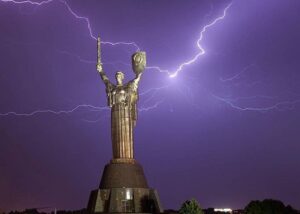
In Zhytomyr and Lvov, they plan to build new thermal power plants on biofuel in a short time to save and reduce the use of natural gas, the press service of NJSC Naftogaz of Ukraine reported.
Naftogaz has begun preparatory work for the construction of thermal power plants that will operate on biomass (wood cod) and solid secondary fuel (RDF) in Lvov and Zhytomyr. The total capacity of the facilities will be 90 MW of thermal energy and 11 MW of electricity. The planned period for putting objects into operation in Lviv is the 1st quarter of 2023, in Zhytomyr – the 4th quarter of 2023,” the text of the release published on the company’s website on Saturday says.
As noted, Naftogaz intends to build at least 9 thermal power plants and bio-boiler houses in 8 regions of Ukraine with a total capacity of 250 MW of thermal energy and 52 MW of electricity.
“The company has an ambitious goal of becoming the largest biomass heat generator by 2027 and replacing about 2 billion cubic meters of natural gas. Ukraine can almost completely abandon the use of natural gas for central heating, replacing it, in particular, with bioenergy,” the statement said. release.
It is reported that during his working trip on September 30 and October 1 to Lviv and Zhytomyr, the head of the board, Yuriy Vitrenko, noted that the NAC helps Ukrainian cities to transfer their CHPPs from gas to biofuel (we are talking about projects in Zhytomyr, Lvov, Akhtyrka) and is ready to support and other cities in this direction.
“We are interested in investing in such projects in order to import less gas at enormous prices. The implementation of such projects is also economically beneficial, and for the environment, such investments quickly pay off, while tax money goes to local budgets, and the number of jobs grows” , Vitrenko stressed.
According to him, a comprehensive approach is needed for a smooth passage of the heating season. In particular, sufficient gas reserves in storage (currently 13.9 billion cubic meters) and stabilization of its own production (gas – IF-U) are the most important tasks for Naftogaz, and the transition of heat generating enterprises to modern technologies and the use of biofuels, and the modernization of networks to reduce heat loss.
In turn, the mayors of Lviv and Zhytomyr Sergey Sukhomlin and Andrey Sadovy noted the successful implementation of this project, which will be able to provide the production of 50 MW of energy generated from alternative fuels and reduce the dependence of cities on natural gas, Naftogaz stressed.
Thus, in Zhytomyr in 2023 they plan to use 10% of the consumed gas, in particular, in 2015, 93 million cubic meters of gas, and in 2022 there should be about 45 million cubic meters. The authorities plan to implement three projects in the city to save gas and turn household waste into heat and electricity.
And in Lvov Novoyavorivsk plans to build a modern thermal power plant in a short time. Sadovyi noted that it will cover about a quarter of the city’s heat needs. The project also includes the construction of a sorting complex for municipal solid waste.
“Cod trees and the organic component of MSW will be used as fuel for the thermal power plant – this is paper, cardboard, food waste, wood, leather, fabric. By implementing this project, we will be able to save $ 24 million that we spent on gas. And the residents of Novoyavorivsk will receive cheaper heat and hot water throughout the year,” the NAC said.
According to the project, the required volume of MSW collection is 70,000 tons per year, which includes 30-35% secondary resources, as well as biodegradable and combustible (65%), namely about 45,000 tons per year. Another fuel component is planned to use wood chips with a volume of 39,000 tons per year.

Another 11 ships with more than 217,000 tons of agricultural products left Ukrainian ports on Saturday for the countries of Africa, Asia and Europe as part of the implementation of the “grain initiative”, the Ministry of Infrastructure reported.
“In particular, bulk carriers Stellina, Queen Lila, Inandi, Sam left the berths of the port of Odessa. Fortune Express, PS Dream, Lila II, Baron left the port of Chernomorsk, and Lady Divina, Ahmed Can, Iasos left the port of Pivdenny “, the ministry said.
The agency indicated that among them was the bulk carrier Queen Lila, carrying 29,000 tons of barley to Libya.
According to the ministry, since the launch of the first vessel with Ukrainian food, their total number has already reached 252, and the total export of agricultural products is 5.7 million tons.
As reported, on July 22, in Istanbul, with the participation of the UN, Russia, Turkey and Ukraine, a document was signed on the creation of a corridor for the export of grain from three Ukrainian ports, Chornomorsk, Odessa and Pivdenny, for a period of 120 days. Ukraine set as its goal to export 3 million tons of agricultural products per month as part of the initiative.

Turkey will not recognize Russia’s request to annex the territories of Donetsk, Luhansk, Kherson and Zaporizhia regions of Ukraine, the Ministry of Foreign Affairs of Turkey has said.
“Türkiye did not recognize Russia’s annexation of Crimea in an illegitimate referendum in 2014 and has emphasized its strong support to Ukraine’s territorial integrity, independence and sovereignty on every occasion. In accordance with this stance adopted in 2014, we reject Russia’s decision to annex the Donetsk, Luhansk, Kherson and Zaporizhia regions of Ukraine,” the Ministry of Foreign Affairs of Turkey said in a statement on its website.
The ministry said that this decision, which constitutes a grave violation of the established principles of international law, cannot be accepted.
“We reiterate our support to the resolution of this war, the severity of which keeps growing, based on a just peace that will be reached through negotiations,” the ministry said.

Azerbaijani gas supplies to Europe will increase by 40% to 11.5 billion cubic meters in 2022, Azerbaijani President Ilham Aliyev said.
“In 2022, our export will reach 22 billion cubic meters, of which 11.5 billion cubic meters will be supplied to consumers in Europe. In 2021, 8.2 billion cubic meters was supplied to Europe. This means a 40% increase in the supplies in 2022,” Aliyev said at the ceremony for putting into commercial operation the Gas Interconnector Greece-Bulgaria (IGB) in Sofia on Saturday.
In accordance with the agreements with the European Union, Azerbaijan plans to at least double its gas export to Europe by 2027.
For that purpose, Baku has begun consultations with its partners on the issue of expansion of the Trans-Anatolian Natural Gas Pipeline (TANAP) to 32 billion cubic meters of gas a year and the Trans Adriatic Pipeline (TAP) to 20 billion cubic meters of gas a year, Aliyev said.
“We have already begun consultations with our partners on the expansion of the TANAP from 16 billion cubic meters to 32 billion cubic meters and the TAP from 10 billion cubic meters to 20 billion cubic meters. Because without it it will be difficult to ensure additional supplies,” the president said.
Aliyev said Azerbaijan has the capabilities to increase the gas export volumes by starting extraction at some other gas deposits.

In Ukraine on Sunday, it is expected to rain at times, at night in the western and northern regions, in the daytime on the Left Bank (except Luhansk region), in some places significant rain, in some places a thunderstorm, reports Ukrhydrometeorological center.
South wind with transition to northwest, 7-12 m/s, gusts of 15-20 m/s in the daytime on the Right Bank.
Temperature at night 9-14 °, in the daytime 13-18 ° (in the highlands of the Carpathians during the day 4-9 °); in the southern part and eastern regions at night 12-17 °, in the daytime 18-23 °, in the Crimea up to 26 °.
In Kyiv on October 2, it sometimes rains. South wind with transition to northwest, 7-12 m/s, daytime gusts of 15-20 m/s.
The temperature at night is 10-12°, during the day about 15°.
According to the Central Geophysical Observatory. Boris Sreznevsky in Kyiv on October 2, the highest temperature during the day was 26.2 ° in 1890, the lowest at night -2.5 ° in 1902.
On Monday, October 3, at times light rain, at night in most of the southern and central regions without precipitation.
Northwest wind with transition to southwest, 7-12 m/s, in Ukraine, except for the southern part, gusts of 15-20 m/s in places.
Temperature at night 3-8° warm, daytime 8-13°; in the southern and eastern parts at night 7-12 °.
In Kyiv on October 3 at night in some places, during the day light rains everywhere.
Wind northwest with transition to southwest, 7-12 m/s, gusts of 15-20 m/s in places.
Temperature at night 6-8° warm, daytime 11-13°.

The number of international travel from January to July 2022 increased to 474 million, which is almost three times more than in the same period last year, according to the UN World Tourism Organization (UNWTO).
“The number of international travel almost tripled from January to July 2022 (plus 172%) compared to the same period in 2021 to 474 million. This means that the industry has recovered 57% from pre-pandemic levels. A sustained recovery in international tourism is being fueled by pent-up travel demand, as well as the lifting or easing of anti-COVID restrictions,” the organization explained.
As noted in the UNWTO, as of mid-September, anti-COVID restrictions ceased to operate in 86 countries around the world.
According to the organization, 207 million international trips were made in June and July 2022, twice as many as in the same period last year. The same months account for 44% of the total number of all arrivals in seven months. Most of the trips were made in Europe – 309 million.
According to the UNWTO, international tourism in Europe and the Middle East is recovering at the fastest pace. From January to July 2022, the number of trips reached 74% and 76% of the 2019 levels, respectively.
“In seven months, the number of international trips in Europe increased by 190% compared to the same period in 2021. This is due to high demand for intra-regional travel, as well as an increase in the number of tourists from the United States. In the Middle East, in January-July 2022, the number of international arrivals almost quadrupled: in July, the number of travels exceeded the pre-pandemic level by 3%, primarily due to pilgrimages to Saudi Arabia,” the organization noted.
As for the Americas, international tourism there recovered to 65% and 60% of the 2019 level and grew by 103% and 171%, respectively, compared to January-July last year.
In the Asia-Pacific region, the number of international travel is still significantly lower (down 86%) compared to 2019. However, compared to 2021, the number of trips increased by 165%.
According to the UNWTO, some sub-regions have been able to restore international travel to 70-85% of pre-pandemic levels. Thus, the Southern Mediterranean, Europe lag behind by 15% from the pre-pandemic 2019, the Caribbean – by 18%, Central America – by 20%, Western and Northern Europe – by 26% and 27%, respectively.